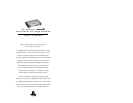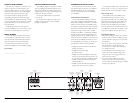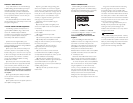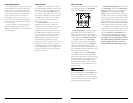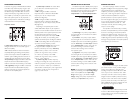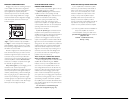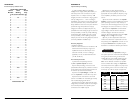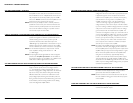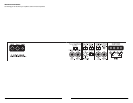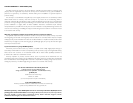
APPENDIX B:
Input Sensitivity Level Setting
JLAudio amplifiers utilizing the Regulated
Intelligent Power Supply (R.I.P.S.) allow delivery of
their rated power when connected to any load
impedance from 1.5 - 4Ω per channel (3 - 8Ω
bridged) and when connected to a charging system
with any voltage from 11 - 14.5V. This design is
beneficial for many reasons. One of these reasons is
ease of setup. Because each JLAudio amplifier will
always deliver the same amount of power within its
operational range of impedances and supply
voltages, the maximum, unclipped output is very
predictable.This makes setting the gain structure via
the input sensitivity controls very simple. Following
the directions below will allow the user to adjust
the input sensitivity of the amplifier(s) simply and
easily in just a few minutes using equipment which is
commonly available in installation bays.
Necessary Equipment
• Digital AC Voltmeter
• CD with a sine-wave test tone recorded at 0 dB
reference level in the frequency range to be
amplified for that set of channels (50 Hz for
subwoofer channels, 1 kHz for a midrange
application). Do not use attenuated test tones
(-10 dB, -20 dB, etc.).
The Nine-Step Procedure
1) Disconnect the speaker(s) from the
amplifier’s “Speaker Outputs”connectors.
2)Turn off all processing on the source unit
(bass/treble, loudness, EQ, etc.). Set fader control to
center position and subwoofer level control to 3/4
of maximum (if used to feed the 300/2).
3) Switch the “Input Voltage” to “Low” and
turn the “Input Sens.” control all the way down.
4) Set the source unit volume to 3/4 of full
volume. This will allow for reasonable gain overlap
with moderate clipping at full volume.
5) Using the chart below, determine the target
voltage for input sensitivity adjustment according to
the nominal impedance of the speaker system
connected to the amplifier outputs.
6)Verify that you have disconnected the
speakers before proceeding. Play a track with an
appropriate sine wave (within the frequency range
to be amplified by the 300/2) at 3/4 source unit
volume.
7) Connect the AC voltmeter to the “Speaker
Outputs” connectors of the amplifier. If the channel
pair is operating in stereo, it is only necessary to
measure one channel. If bridged, make sure you test
the voltage at the correct connectors (L+ and R–).
8) Increase the “Input Sens.” control until the
target voltage is observed with the voltmeter. If
excessive voltage is read with the control at
minimum (full counterclockwise), switch the “Input
Voltage” switch to “High” and re-adjust.
9) Once you have adjusted the 300/2 to its
maximum low-distortion output level, reconnect
the speaker(s).The “Input Sens.” controls can now
be adjusted downward if the amplifier requires
attenuation to achieve the desired system balance.
Do not increase any “Input Sens.” setting in
the system beyond the maximum level established
during this procedure. Doing so will result in
audible distortion and possible speaker damage.
It will be necessary to re-adjust the “Input
Sens.” for the affected channels if any equalizer
boost is activated after setting the “Input Sens.”
with this procedure.This applies to any EQ boost
circuit, including source unit tone controls or EQ
circuits. EQ cuts will not require re-adjustment.
IMPORTANT
!
JL AUDIO 300/2 13
Nom. Target AC Voltage
Impedance Stereo Bridged
8Ω 24.5 V 49.0 V
6Ω 24.5 V 42.4 V
4Ω 24.5 V 34.6 V
3Ω 21.2 V 30.0 V
2Ω 17.3 V not
recommended
1.5Ω 15.0 V not
recommended
12 JL AUDIO 300/2
APPENDIX A:
Precise Frequency Selection Chart
“FILTER FREQ” AMP FILTER
Detent Panel Actual
Number Marking Freq.
Full counter-clockwise: 58
01 . . . . . . . . . . . . . . . . . . . . . . . .58
02 . . . . . . . . .“50” . . . . . . . . .58
03 . . . . . . . . . . . . . . . . . . . . . . . .58
04 . . . . . . . . . . . . . . . . . . . . . . . .58
05 . . . . . . . . . . . . . . . . . . . . . . . .59
06 . . . . . . . . . . . . . . . . . . . . . . . .60
07 . . . . . . . . . . . . . . . . . . . . . . . .61
08 . . . . . . . . .“60” . . . . . . . . .63
09 . . . . . . . . . . . . . . . . . . . . . . . .65
10 . . . . . . . . . . . . . . . . . . . . . . . .67
11 . . . . . . . . . . . . . . . . . . . . . . . .69
12 . . . . . . . . . . . . . . . . . . . . . . . .71
13 . . . . . . . . . . . . . . . . . . . . . . . .74
14 . . . . . . . . .“75” . . . . . . . . .77
15 . . . . . . . . . . . . . . . . . . . . . . . .80
16 . . . . . . . . . . . . . . . . . . . . . . . .82
17 . . . . . . . . . . . . . . . . . . . . . . . .85
18 . . . . . . . . . . . . . . . . . . . . . . . .90
19 . . . . . . . . . . . . . . . . . . . . . . . .93
20 . . . . . . . . .“95” . . . . . . . . .97
21 . . . . . . . . . . . . . . . . . . . . . . .102
22 . . . . . . . . . . . . . . . . . . . . . . .107
23 . . . . . . . . . . . . . . . . . . . . . . .113
24 . . . . . . . . . . . . . . . . . . . . . . .120
25 . . . . . . . . . . . . . . . . . . . . . . .127
26 . . . . . . . . .“130” . . . . . . . .135
27 . . . . . . . . . . . . . . . . . . . . . . .143
28 . . . . . . . . . . . . . . . . . . . . . . .153
29 . . . . . . . . . . . . . . . . . . . . . . .171
30 . . . . . . . . . . . . . . . . . . . . . . .182
31 . . . . . . . . . . . . . . . . . . . . . . .201
32 . . . . . . . . .“200” . . . . . . . .223
33 . . . . . . . . . . . . . . . . . . . . . . .253
34 . . . . . . . . . . . . . . . . . . . . . . .289
35 . . . . . . . . . . . . . . . . . . . . . . .337
36 . . . . . . . . . . . . . . . . . . . . . . .404
37 . . . . . . . . . . . . . . . . . . . . . . .474
38 . . . . . . . . .“500” . . . . . . . .514
39 . . . . . . . . . . . . . . . . . . . . . . .525
Full-clockwise: 542



